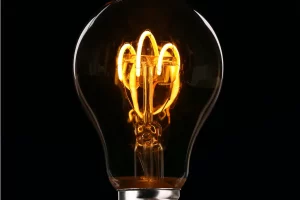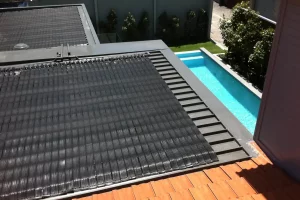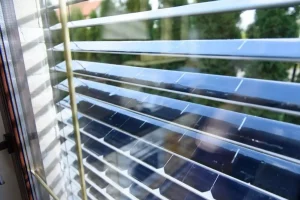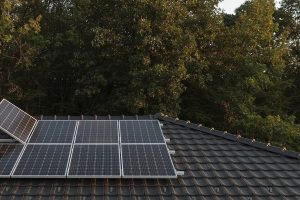From torrential rain and heavy snowfall to gusty winds and scorching heat, our planet is home to a diverse range of climates, each with its own unique challenges. Understanding how solar panels fare in the face of inclement weather is essential for those considering investing in this green energy solution.
In this article, we look into the performance, durability, and safety aspects of solar panels when confronted with bad weather:
- Is it safe using solar panels when it’s raining
- Can snow damage solar panels
- How snow affects solar panel performance
- Solar panel hail damage – is it safe to use solar panels during hail
- What are the challenges of using solar panels during strong winds
- What are the risks of using solar panels in hurricane
- Can too much heat damage solar panels
Is it safe using solar panels when it’s raining?
Yes, it is safe to use solar panels when it is raining. Rain does not pose a significant risk to the safety or functionality of solar panels. In fact, rain can have some positive effects on the performance of solar panels. Here are a few important points to consider:
- Solar panels are designed to be waterproof and are built with materials that can withstand exposure to rain and moisture. They are constructed with a protective layer of glass or other materials that shield the internal components from water damage.
- Rain can help clean the surface of solar panels, removing dust, dirt, and debris that may have accumulated. Cleaner panels allow for better absorption of sunlight, improving overall energy production.
- Solar panels are designed to generate electricity from sunlight, not raindrops. Rain does not interfere with the process of converting sunlight into electricity, as the panels are capable of capturing the available light energy even on cloudy or rainy days. However, the amount of electricity produced may be slightly reduced compared to clear sunny conditions.
- Solar panels are equipped with protective measures, such as electrical insulation and grounding, to ensure safety during wet conditions. They undergo rigorous testing to meet electrical safety standards and regulations.
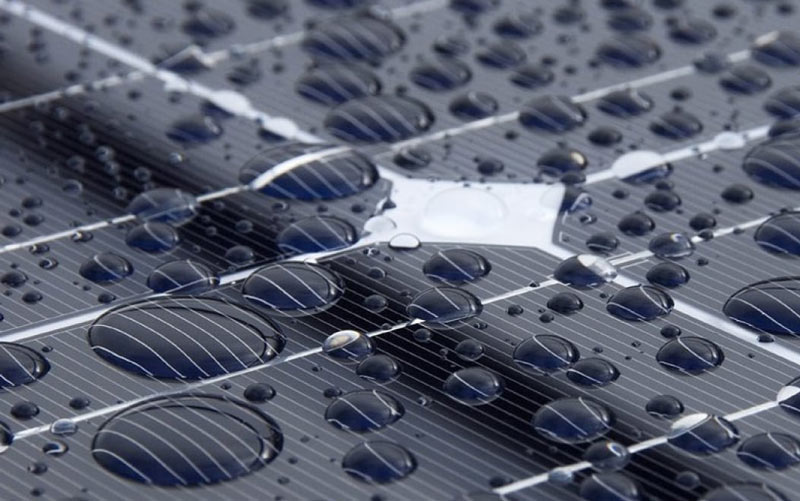
While it is generally safe to use solar panels during rain, it is important to have the solar panel system properly installed by professionals who adhere to local electrical codes and industry best practices.
Can snow damage solar panels?
Snow generally does not damage solar panels, as they are designed to withstand various weather conditions, including snow loads. However, there are some considerations to keep in mind.
Weight and structural integrity of solar panel mounting construction
Snow can add weight to the panels and their mounting structures. Solar panels are typically designed to handle specific snow loads based on regional building codes and standards. Properly installed systems with appropriate structural support should be able to handle normal snow accumulation without issues. However, in cases of exceptionally heavy snow or prolonged snowfall, it’s advisable to monitor the snow load and ensure that the mounting system remains secure.
Potential for ice dams
In some cases, when snow melts and refreezes on the edges of the panels or on the roof, it can form ice dams. Ice dams can obstruct the proper drainage of water and potentially cause water infiltration into the system or the roof. It’s important to address ice dams promptly to prevent any damage.
Snow sliding or shedding
As the snow on a sloped solar panel surface starts to melt or slide, it can potentially create an avalanche-like effect, causing a large amount of snow to rapidly slide off the panel. This sliding snow can be a safety hazard for people below. Therefore, it’s important to take appropriate precautions and place warning signs or barriers to prevent accidents.
Electrical safety
During snowfall or after a snowstorm, it’s important to exercise caution around electrical components, including the wiring and connections of solar panel systems. Ensure that the system is properly grounded and avoid contact with any exposed electrical components when there is snow or moisture present.
How snow affects solar panel performance
Snow can affect the performance of solar panels, as it can obstruct sunlight from reaching the surface of the panels. However, snow is generally not considered “bad” for solar panels, and they are designed to handle snow loads and continue functioning.
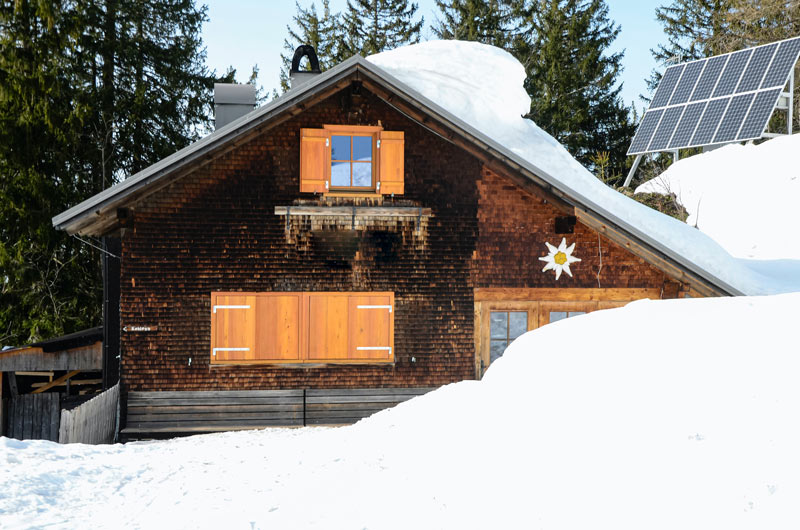
When snow accumulates on the surface of solar panels, it blocks sunlight and reduces the amount of energy the panels can generate. The extent of power loss depends on factors such as the thickness of the snow and the angle of the panels. It’s important to note that even in snowy conditions, solar panels can still generate some electricity, albeit at a reduced capacity.
In some cases, it may be beneficial to manually remove snow from solar panels to restore their optimal performance. However, it’s essential to exercise caution and follow proper techniques to avoid damage.
Solar panel hail damage – is it safe to use solar panels during hail?
Solar panels are designed to withstand a variety of weather conditions, including hailstorms. While no solar panel can be completely hail-proof, most solar panels are built to withstand standard-sized hailstones without being damaged. The specific safety of using solar panels in hail depends on factors such as the size and speed of the hailstones, the angle of the solar panels, and the quality of the panel materials.
Solar panels are tested and certified to meet certain industry standards and regulations, which often include hail testing. These tests involve shooting hailstones at the panels to simulate hail impact and ensure they can withstand a certain level of force. Panels that meet these standards should be able to handle hailstones of a specific size without significant damage.
However, it’s important to note that extremely severe hailstorms with large hailstones or high-speed winds may cause damage to solar panels, just as they can cause damage to other structures and surfaces. In such cases, there is a possibility of the panels sustaining some level of damage or even complete destruction.
If you live in an area prone to frequent or severe hailstorms, it’s a good idea to consider factors like the quality and durability of the solar panels you choose. Some manufacturers offer panels specifically designed to be more hail-resistant or provide additional protective measures, such as reinforced glass or encapsulation technologies.
Additionally, solar panels are typically installed at an angle, which can help reduce the direct impact of hailstones.
What are the challenges of using solar panels during strong winds
Using solar panels during high winds presents a few challenges that need to be addressed to ensure the safety and optimal performance of the system. Here are some key challenges associated with high winds and solar panels.
Mechanical stress on panels and mounting
High winds exert significant mechanical forces on solar panels and their mounting systems. If not properly installed or adequately secured, strong gusts can potentially cause the panels to shift, loosen, or even detach from their mounts. This can lead to damage to the panels, wiring, or other components of the system.
Wind resistance and structural integrity
Solar panels should be installed using appropriate mounting systems designed to withstand the wind loads specific to the location. Building codes and regulations often define minimum wind resistance requirements for solar installations. Ensuring that the mounting structure is engineered and installed correctly is crucial to withstand the wind forces and maintain the structural integrity of the system.
Aerodynamic considerations
The design and placement of solar panels can impact their vulnerability to wind. Panels installed at a flat angle or with inadequate spacing between rows may create a larger surface area for wind to exert force on, increasing the risk of damage. Tilting the panels or using appropriate spacing can help reduce the wind load and improve aerodynamic performance.
Wind-induced vibration and noise
In some cases, high winds can cause vibrations in the solar panels or mounting structures, leading to audible noise. While these vibrations may not pose a safety risk, they can be a concern for aesthetic or comfort reasons, especially in residential or noise-sensitive areas.
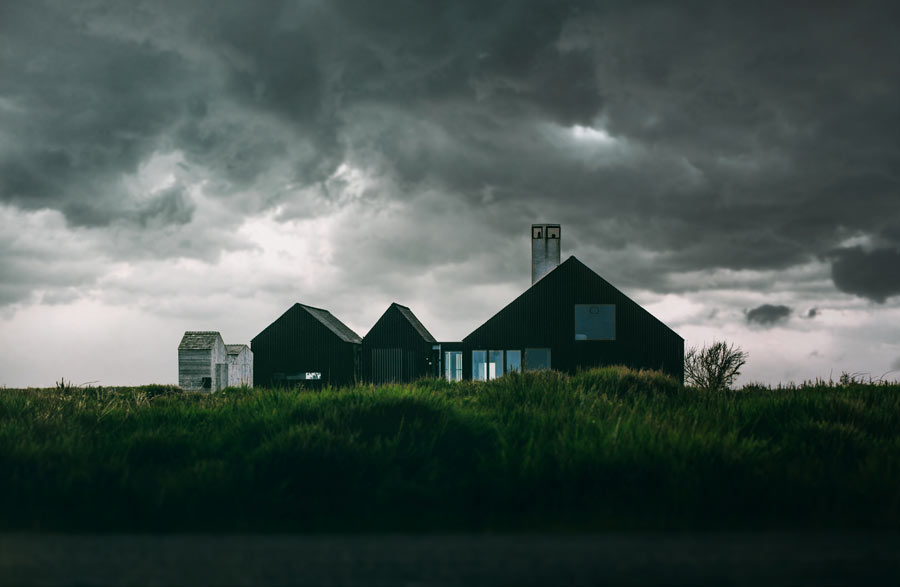
To mitigate the challenges of using solar panels during high winds, it is crucial to consider the following measures:
- Engage a professional solar installer with experience in designing and installing systems that meet local wind load requirements.
- Ensure proper structural support and anchoring of the mounting system to withstand high wind speeds.
- Regularly inspect the installation to identify any loose or damaged components and address them promptly.
- Consider using wind-resistant mounting systems or technologies specifically designed to improve the system’s stability in high winds.
- Monitor weather conditions and consider taking precautionary measures, such as temporarily shutting down the system during severe storms or hurricanes.
By addressing these challenges and implementing appropriate measures, solar panel systems can withstand high winds and continue generating clean energy reliably and safely.
What are the risks of using solar panels in hurricane?
Hurricanes are powerful weather events that can bring high winds, heavy rain, and flying debris, all of which can pose significant risks to solar panels and their supporting infrastructure.
The main concerns regarding the use of solar panels during a hurricane include:
- Wind damage. Hurricanes can generate extremely high wind speeds that can cause significant damage to solar panels. Even if the panels are securely installed, there is still a risk of them being torn off or damaged by strong gusts of wind.
- Flying debris. During a hurricane, debris such as branches, roof tiles, and other objects can become airborne and potentially strike solar panels. This can result in physical damage to the panels and impair their performance.
- Electrical safety. Solar panel systems are connected to the electrical grid or have battery storage systems. During a hurricane, power outages and electrical disruptions are common. Working with electrical systems during severe weather conditions can be dangerous, and there is an increased risk of electrocution.
To mitigate these risks, it is generally advised to take precautions when a hurricane is approaching. These precautions may include:
- Turning off the system and disconnecting it from the electrical grid can help minimize the risk of electrical hazards during the storm.
- If possible, take measures to secure the solar panels, such as removing them temporarily or reinforcing their mounting to withstand high winds.
- Check the manufacturer’s recommendations for severe weather conditions and follow their instructions to ensure the safety of your solar panel system.
It’s important to note that the specific recommendations and guidelines may vary depending on the type of solar panels, the mounting system, and the local building codes and regulations.
Can too much heat damage solar panels?
Solar panels are designed to withstand high temperatures, and they are generally not easily damaged by excessive heat. In fact, solar panels are known to perform better in cooler temperatures due to the nature of their semiconductor materials. However, there are a few considerations regarding heat and solar panels.
Solar panels are tested and manufactured to withstand a wide range of temperatures. Most solar panels have a temperature tolerance range typically between -40°C to 85°C (-40°F to 185°F) or even higher. They are designed to handle the heat generated by sunlight during normal operating conditions.
High temperatures can affect the performance of solar panels. When solar panels get excessively hot, there is a slight decrease in their efficiency. This is because the increase in temperature can lead to a slight increase in the resistance of the solar cells, resulting in a small reduction in power output. However, this decrease in efficiency is typically minimal and does not cause significant damage to the panels.
Solar panel installations are typically designed with proper ventilation and air circulation to dissipate heat effectively. This helps to prevent excessive heat buildup and maintain optimal operating temperatures. Mounting the panels a few inches above the roof surface can also help with airflow and heat dissipation.
High temperatures alone are not likely to cause significant damage to solar panels, especially if they are properly installed and of good quality. However, it’s important to ensure that the materials used in the panels and their components are of high quality and can withstand prolonged exposure to heat without degrading over time.
It’s worth noting that extreme heat waves or exceptionally high temperatures, especially when combined with other factors like dust or high humidity, can potentially impact the long-term performance and lifespan of solar panels. However, such cases are relatively rare and generally not a concern in normal operating conditions.
To maximize the performance and longevity of solar panels in hot climates, regular maintenance, such as cleaning the panels to remove dust and debris, can help prevent any performance degradation.
Conclusion
In the face of challenging weather conditions, solar panels have proven themselves as robust and reliable sources of renewable energy. As we’ve explored in this article, rain, snow, wind, and heat may impact the performance and efficiency of solar panels to varying degrees, but they are designed to handle these elements with resilience.
Solar panels, when integrated thoughtfully into our energy systems, offer an environmentally friendly solution that can weather the storms and provide a reliable source of power year-round. With advancements in technology and ongoing research, solar panels will only become more efficient and resilient, ensuring their longevity as a cornerstone of the renewable energy transition.
